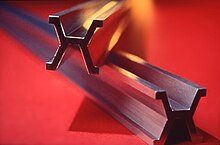Platynoiryd
| Ten artykuł od 2022-04 wymaga zweryfikowania podanych informacji. |

Platynoiryd – stop platyny z irydem. Jego cechą charakterystyczną jest duża twardość, stąd stosowany bywa w stomatologii oraz we wzorcach (np. wzorzec metra i kilograma zostały sporządzone ze stopu składającego się w 90% z platyny i 10% z irydu).
Media użyte na tej stronie
Computer generated image of International Prototype Metre bar, made of 90% platinum - 10% iridium alloy. This was the standard of length for the SI (Metric system) from 1889 until 1960, when the SI system changed to a new definition of length based on the wavelength of light emitted by krypton 86. The length of the metre was defined by the distance between two fine lines ruled on the central rib of the bar near the ends, at the temperature of freezing water. The bar was given an X (Tresca) cross-sectional shape to increase its stiffness-to-weight ratio, improve its thermal accommodation time, and so the graduation lines could be located on the "neutral" axis of the bar where the change in length with flexure is minimum. The prototype was made in 1889, its length made equal to the previous French standard "Metre of the Archives". Twenty-nine identical copies were made at the same time, which were calibrated against the prototype and distributed to nations to serve as national standards.
The main problem with defining the unit of length by an artifact such as a bar is that there is no foolproof way of detecting a change in its length due to age or misuse. It can be compared to other copies, but these themselves may have changed in length. This motivated the 1960 change to a definition based on light waves. The bar is now kept in the collection of the BIPM museum.
